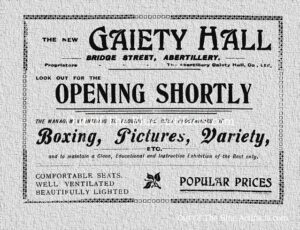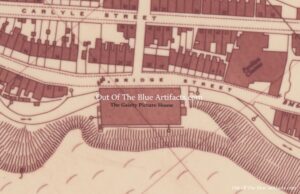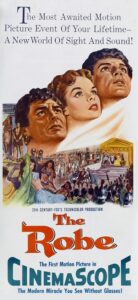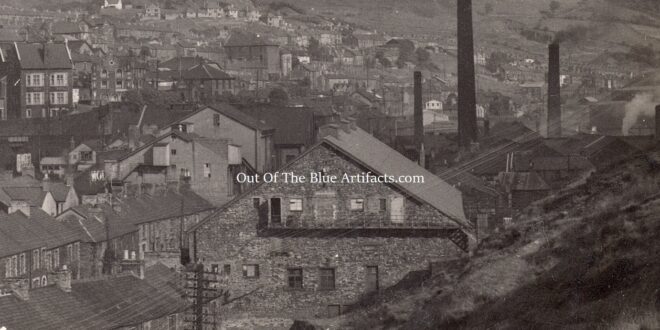 The Gaiety Hall – Abertillery.
The Gaiety Hall – Abertillery.
The construction of the Gaiety Hall began when a few prominent businessmen in Abertillery formed the Abertillery Gaiety Hall Company Limited.
On Thursday 25th of March 1920, the Bioscope Newspaper printed a report on new companies, it featured the Abertillery Gaiety Hall Company Limited which had been registered on 13th March 1920. The company had a capital of £5,000 in £1 shares to carry on the business of theatre, music-hall, concert hall, ballroom, circus, hippodrome, cinema, rink, billiard hall and boxing hall proprietors etc and to adopt an agreement between Mr W. T. Harvey; Mr W. J. Chivers; Mr W. Lewis and Mr S. Watkins. The first directors were – Mr W. T. Harvey of Bryn Eirn, Alexandra Road, Abertillery; Mr W. J. Chivers of the Railway Hotel, Abertillery; Mr S. Watkins 3 Park View, Abertillery and Mr W. Lewis of the Imperial Stores, Blaina: Mr W. J. Chivers (Secretary): Registered Office – Railway Hotel, Abertillery.
 The Site for the Gaiety Hall.
The Site for the Gaiety Hall.
In 1921 the construction was in progress, the Gaiety Hall was situated at Bridge Street Abertillery (as seen on the map, right). The building spanned the River Ebbw upon large foundations placed each side of the riverbank with the river flowing under the full length of the theatre.
It was situated close to the Old Blaina Road and the entrance to the Bottom Park, Abertillery. It was only yards away from the Empress Cinema and the Pavilion Theatre. The construction was at great expense to the Gaiety Hall Company.
Mr Sydney Watkins.
The Gaiety Hall, Abertillery was built by the Abertillery Contractor Mr Sidney Watkins, he also built the Olympia Picture House at Newport. Mr Watkins was one of the first directors of the Abertillery Gaiety Hall Company Limited and in 1924 became the landlord of the Crown Inn Blaenau Gwent.
Mr Ernest J. Price.
Mr Ernest J. Price was the resident manager. The building was a very large one and had been luxuriously furnished and with the modern requirements.
Description of the Building.
The whole building (its roof can be seen centre right in the main featured image above) was made from stone and faced with brick. The roof was constructed with three lantern roofs for ventilation and lighting. The outside measurements were 146′ feet in length and 70′ feet wide, with entrances on the main road one at each end. The interior was 120′ feet by 65′ feet exclusive of offices of which there were three leading from the main entrance and ladies and gentleman’s toilet rooms in addition to the operating box. The flat portion of the stage was 40′ foot square rising by six tiers of 2′ feet 6″ inches on either side, while the stage opening to the auditorium was 33′ feet wide.
The floor was arranged at a convenient slope to allow an uninterrupted view from every seat. The orchestra were accommodated in a roomy space railed off at the front of the stage. Dressing rooms were provided underneath the stage and the heating arrangements were on the steam method throughout. In addition to fire extinguishers there were also fire hydrants laid down in the event of a fire. The operating box was fire-proof.
The electric lighting was developed by means of a twenty-six horse-power engine driving a powerful dynamo of an improved pattern. The interior was decorated with a buff colour with panelling picked out in white, with all lights frosted and dome shaped with rich brass fittings. Tip-up Morrocco Pegmoid chairs comprised the seating in the main hall, while the balconies were provided with elaborate tip-up plush seating. There were also two Kayley model machines equipped with motors to show pictures.
The Official Opening.
On Saturday 24th of December 1921, the Gaiety Hall, Abertillery was officially opened. Alderman Mr Levi Harris acted as M.C. and stated that “The Gaiety Hall Abertillery was regarded as one of the best sporting centres in England and Wales. “It was an endeavour to provide sport as it ought to be – free and untrammelled, they had a certain amount of antipathy to break down but they hoped to be able to do so”. Later a programme of boxing proceeded.
The Boxing Competitions.
The main bout of boxing started with a contest of ten-rounds for £15.00 per side and the promoter’s purse between – Mr Billy Grubb of Brynmawr and Mr Victor Charles of Tredegar. Refereed by Mr C. Barnett of Cardiff with the Timekeeper Mr A. Ashman. Mr Billy Grubb won on points. The next bout was between Mr Burt Bullock and Seaman Cutland, both of Abertillery. Mr Cutland won on points.
The featured bout was a 20 three-minute rounder for the Light Weight Championship of Wales and the prize of £300.00 and a silver cup presented by Mr W. T. Harvey, between Mr Joseph and Mr Morgan though the referee had intimated that the pair failed to meet the weight and the contest could not be fought for the championship, they promised to meet again to battle each other officially though went ahead to fight on the night and it went the distance there was nothing between the two but in the end Mr Morgan was given the decision by the referee Mr Barrett. The night ended with a comedy farce boxing bout put on by Barrett’s Boxing Boys.
The First Picture Shows.
On Monday 2nd of January 1922, the first week’s bill of pictures shown were as follows – “Out Yonder”, Starring Miss Olive Thomas; “Beyond the Dreams of Avarice” Starring Mrs Joyce Dearsley; “His Naughty Night, a two-reel Monty Banks comedy:
The Death of Mr Sidney Watkins.
In November 1924 Mr Sidney Watkins the contractor that built the Gaiety Hall sadly died aged just 51 years, he left a widow, three daughters – Misses Phyllis, Eveline and Iris and two sons Cyril and Harold.
The Abertillery Theatres Limited.
In the late 1920’s all the Abertillery Picture Houses were owned by the Abertillery Theatres Limited. The general manager of the company was Mr Albert Jackson Withers.
Gaiety Theatre.
The Gaiety Hall was later known as the Gaiety Theatre.
Cinemascope.
In July 1953, 20th Century-Fox hired the Odeon, Tottenham Court Road, London for four days of demonstrations of the new presentational process called “Cinemascope” and in November 1953 the first movie filmed in Cinemascope “The Robe” opened to great acclaim at the Odeon, Leicester Square. The process reached Cardiff on 11th January 1954 but took quite a while to come to Monmouthshire and the valleys.
The Gaiety Theatre Chosen to Premiere Cinemascope.
In November 1954 the Gaiety Theatre, Abertillery was chosen to premiere CinemaScope. Mr A. E. V. Dawes, Manager of the Gaiety Theatre told the South Wales Gazette – The Gaiety Theatre had been fully renovated and re-equipped with a new panoramic screen, size 39′ x 26′ feet, with special projection and sound equipment. Its life-like panoramic scope, plus stereophonic sound, combine to make the audience experience complete engulfment and participation in the action. At this time, it was the first demonstration in Monmouthshire with even Newport missing out until January 1955.
 The CinemaScope Feature Film – The Robe.
The CinemaScope Feature Film – The Robe.
On Monday 15th of November 1954, the Gaiety Theatre, Abertillery showed its first CinemaScope film production “The Robe” starring Richard Burton, Jean Simmons and Victor Mature. As stated, this was the first showing of a film in CinemaScope in Monmouthshire.
The Last Film at the Gaiety Theatre.
On Monday (Spring Bank Holiday) 18th of May 1959, the last movie shown at the Gaiety Theatre, Abertillery was “The Sign of Zorro”.
The Closure of The Gaiety Theatre.
On Saturday 23rd of May 1959, the Gaiety Theatre, Abertillery closed.
Clothing Factory Proposal.
On Friday 13th of December 1963, the South Wales Gazette reported that there was interest shown in clothing factories wanting to locate at Abertillery and the Board of Trade in Wales said they were pretty sure that if a large enough building suitable for light industry became available in Abertillery it would be occupied very quickly. A sub-note stated that the Abertillery Council’s Roads, Bridges and General Purposes Committee were told that a sub-committee were investigating the offer of two former cinema’s, the Pavilion and the Gaiety for industrial use.
The Demolition of the Gaiety Theatre.
On Friday 26th of August 1966, the South Wales Gazette reported that the Gaiety Theatre was to be demolished. It stated the owners had obtained demolition estimates and that work was to commence shortly. The demolition was carried out in October 1966.
The Later Years.
The Gaiety Theatre was later demolished, the large concrete foundation blocks can still be seen on the riverbank opposite Bridge Street.
Extra information on the Gaiety Theatre was kindly provided courtesy of Mr Phillip Walkley.
 Out Of The Blue Artifacts A Library of a lifetime of collecting
Out Of The Blue Artifacts A Library of a lifetime of collecting
